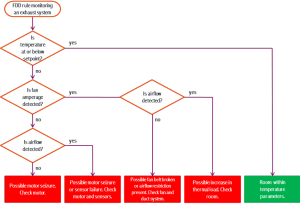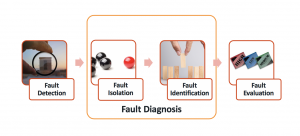We have all experienced the frustration of not having our household appliances or electronic devices work as intended. During those times, we wish we would quickly know what is wrong, learn how to fix them, and move on with our lives. Many modern machines available today offer features to help us troubleshoot them whenever common problems arise. In fact, fault detection and diagnostics surround us in our everyday lives, a standard feature seemingly everywhere, from our smart coffee machines to our computerized vehicles to our office printers and photocopiers.
The concept of fault detection and diagnostics has been around for several decades, finding practical application in several fields including aerospace, automotive, manufacturing, nuclear and national defense. In this brief article, we focus on the one field where research and development efforts have categorically increased over the last two decades. That is the field of buildings and Heating, Ventilation, Air Conditioning, and Refrigeration (HVAC&R) systems.
What is Fault Detection and Diagnostics in Buildings?
In essence, Fault Detection and Diagnostics, or FDD, is the process of uncovering errors in physical systems while attempting to identify the source of the problem. In buildings, these physical systems include HVAC&R – systems designed to maintain the indoor environment acceptable to people, products and equipment – as well as lighting, elevators and any specialized equipment residing in the confines of the thousands of buildings all around us.
The term Automated Fault Detection and Diagnostics, or AFDD, has become more prominent lately, particularly in the building industry. In general, the differentiation made is that while FDD commonly refers to the process, AFDD refers to the technologies used to implement FDD processes. An AFDD tool is therefore equipped to implement automated FDD with as little human intervention as possible.
How does Fault Detection and Diagnostics work?
The basic methodology in FDD involves four key processes, fault detection, fault isolation, fault identification, and fault evaluation, as shown in figure 1. Once it has been determined that a fault has occurred in the system, it is isolated and classified based on the fault type, location and detection time. Fault isolation, together with fault identification – which includes determining the fault size and how it behaves at different times – are commonly referred to as fault diagnosis. Fault evaluation is basically an assessment to determine the fault’s impact on system performance, often based on different prioritization categories including energy, comfort, environmental and cost impact.
Following fault evaluation, a decision needs to be made on how to respond to the fault discovered. The next steps may range from taking corrective action, initiating further investigation, fine-tuning the FDD definition – in the case of a false positive, to delaying or even taking no action.
What are the different approaches to Fault Detection and Diagnostics?
While several different methods for detecting faults and diagnosing their cause exist, they mostly fall under one of three groups generally accepted in the classification of FDD methods. These are, quantitative model-based, qualitative model-based and process history-based.
Quantitative model-based approaches, which base the diagnostics on physical models, aren’t used extensively in commercial AFDD tools. In contrast, qualitative model-based approaches such as rule-based FDD are extensively used in the industry to model the process or system to diagnose faults. Process history-based approaches use large amounts of historical data, with or without engineering knowledge, to derive regression models, neural networks, and other pattern-recognition methods. Belonging to this latter group, many AFDD providers are engaged in extensive research focusing on various data-driven approaches.
How would a Fault Detection and Diagnostics rule work on a building system?
The flow chart in figure 2 is an oversimplified FDD rule that explains the basics of how a fault would be detected and diagnosed.

Figure 2. Flow chart depicting a simplistic FDD rule on an exhaust fan system used for the ventilation of an electrical equipment room.
The goal of the exhaust system is to provide ventilation to an electrical equipment room. During normal sequence of operation, when the temperature in the space rises above the required setpoint, the fan turns on, and once the temperature drops below the setpoint plus a differential, the fan turns off. The three monitoring points include the airflow in the exhaust duct, the fan amperage, and the space temperature in the equipment room. In this simplistic approach, the FDD rule detects a fault and attempts to diagnose the problem using the three available sensor readings.
Why implement fault detection and diagnostics in buildings?
Because of the negative impact equipment and operational faults have on buildings, estimated at five to sometimes even thirty percent of the energy used in commercial buildings wasted, AFDD tools are proven solutions that improve building performance and comfort, reduce energy, and ultimately save time and money.
If the implementation of AFDD technology is being considered for your facility or portfolio, or you want to learn more about the FDD process, contact us today.


